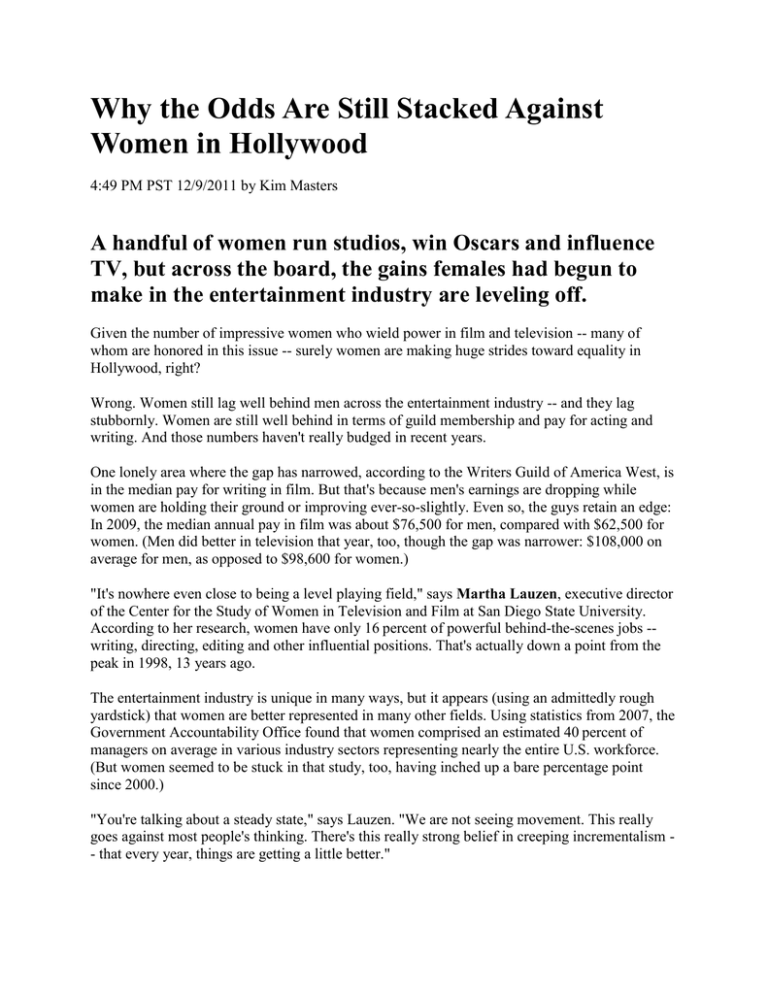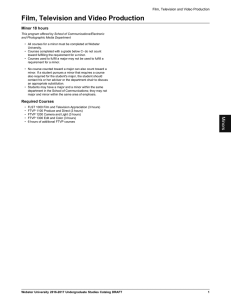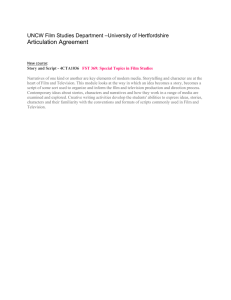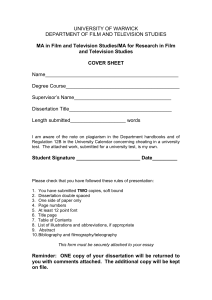Why the Odds Are Still Stacked Against Women in Hollywood.docx
advertisement

Why the Odds Are Still Stacked Against Women in Hollywood 4:49 PM PST 12/9/2011 by Kim Masters A handful of women run studios, win Oscars and influence TV, but across the board, the gains females had begun to make in the entertainment industry are leveling off. Given the number of impressive women who wield power in film and television -- many of whom are honored in this issue -- surely women are making huge strides toward equality in Hollywood, right? Wrong. Women still lag well behind men across the entertainment industry -- and they lag stubbornly. Women are still well behind in terms of guild membership and pay for acting and writing. And those numbers haven't really budged in recent years. One lonely area where the gap has narrowed, according to the Writers Guild of America West, is in the median pay for writing in film. But that's because men's earnings are dropping while women are holding their ground or improving ever-so-slightly. Even so, the guys retain an edge: In 2009, the median annual pay in film was about $76,500 for men, compared with $62,500 for women. (Men did better in television that year, too, though the gap was narrower: $108,000 on average for men, as opposed to $98,600 for women.) "It's nowhere even close to being a level playing field," says Martha Lauzen, executive director of the Center for the Study of Women in Television and Film at San Diego State University. According to her research, women have only 16 percent of powerful behind-the-scenes jobs -writing, directing, editing and other influential positions. That's actually down a point from the peak in 1998, 13 years ago. The entertainment industry is unique in many ways, but it appears (using an admittedly rough yardstick) that women are better represented in many other fields. Using statistics from 2007, the Government Accountability Office found that women comprised an estimated 40 percent of managers on average in various industry sectors representing nearly the entire U.S. workforce. (But women seemed to be stuck in that study, too, having inched up a bare percentage point since 2000.) "You're talking about a steady state," says Lauzen. "We are not seeing movement. This really goes against most people's thinking. There's this really strong belief in creeping incrementalism - that every year, things are getting a little better." It is still just about possible to count the number of women who have run a film studio on one hand: Amy Pascal at Sony; Stacey Snider, formerly at Universal and now a partner at DreamWorks; Donna Langley, co-chair at Universal; and Sherry Lansing, who paved the way at Paramount. And while a few have made it to top jobs at the broadcast and cable networks, there are practically none who don't report to a man (an exception: Abbe Raven, president and CEO of A+E Networks). Perhaps because of their limited power at the top, women seem to run behind in other major industry jobs. Female directors comprise only 13.4 percent of their guild, and a recent study from USC's Annenberg School for Communication & Journalism found that a minuscule 3.6 percent of directors on the top-grossing movies of 2009 were female. Those films included the animated/live-action hybrid Alvin and the Chipmunks: The Squeakquel (directed by Betty Thomas, it grossed $443 million worldwide) and the romantic comedy The Proposal (directed by Anne Fletcher, it pulled in $317 million worldwide). On those top films, 13.5 percent of the writers were women (such as Melissa Rosenberg, whose Twilight Saga installment New Moon was the No. 4 film that year). In front of the camera, men long have dominated in both television and film. The latest Screen Actors Guild figures reveal that an average of 62 percent of roles went to men versus 38 percent to women. Factor in age, and guess what happens? "Whether you're a man or a woman, there's a sweet spot during your career when you can hope to make a good living," says SAG's Adam Moore. "For a woman, that window is narrower than it is for men. It's not a terribly encouraging picture." On top of that, the list of stars who command top dollar is packed with Y chromosomes. With the exception of Angelina Jolie in an action role or a couple of key players in ensembles (Emma Watson in Harry Potter or Kristen Stewart in Twilight), women cannot touch the salaries that go to top male earners. Lauzen doesn't tally the percentage of women in executive jobs, but industry veteran Gail Berman -- who has had top jobs in film and television -- doesn't think there is much of a crack in the ceiling. "It's been a male-dominated business since the beginning of time," she says. "It hasn't changed all that much." At a glance, it would appear women might fare better as producers than in other behind-thecamera jobs. Vance Van Petten, Producers Guild of America executive director, estimates that women make up around half its 4,850 members. The organization doesn't break down its membership by level, though, so there is no information on how many women are on the top rung. Van Petten believes that "women are getting up to speed very quickly in a medium that 15 or 20 years ago was dominated by men." If so, then producing is something of a high-end ghetto. Producer Lauren Shuler Donner notes that though she has produced the X-Men series, and the late trailblazer Laura Ziskin produced the Spider-Man films, women generally have been shut out from directing big action movies. And "comedy is run by a few guys," she says. Shuler Donner says even a sleeper hit like Bridesmaids (written by women, but produced and directed by a men) probably won't translate into real change. "Every year there's one breakthrough female movie, and we always hope it will have an impact," she says. The big exception when it comes to directing is Kathryn Bigelow, who became the first woman in the field to win a best director Oscar, claiming the prize for 2009's The Hurt Locker. But Lauzen sees sexism even in that victory: She observes that Bigelow got the award for "a very male-driven vehicle," and that much of what was written about her had to do with "her relationship with Jim Cameron, her looks and her age." While it might appear that women do better in TV than film, those numbers might be deceiving. Television provides more opportunities for women to write and direct simply because of the sheer number of episodes. Some women note that TV is open because it's perceived as lower in status than film (though often higher in profit). Perhaps also significant, says Lauzen, is the fact that the relationship between consumers and advertisers is very direct in television, and women influence 85 percent of consumer choices in that sector. That might help explain why so many women (Bonnie Hammer, Lauren Zalaznick) have top jobs running cable channels, which are usually aimed at niche audiences, while the broadcast networks try to erect a big tent. In the broadcast world, only two women -- Shonda Rhimes and Carol Mendelsohn -- have big overall deals. Still, Gale Anne Hurd, executive producer of the AMC genre hit The Walking Dead, hopes television will become a gateway. "There are a lot more successful women directors in television, and I'm hoping that there's going to be less of a divide between film and TV," she says. "I'd like to think that television is going to be where we find a lot of exciting, talented women." But even in television, Lauzen says the percentage of women in positions of influence is static after years of slow progress. And Kim Myers, director of diversity at WGA West, observes that though women might find jobs more plentiful in TV, "the networks and studios are still maledominated." When women do get an opportunity in television, she adds, they don't get nearly as much room to fail. "It's such a corporate world now -- people want to buy a brand name," says Myers. "If you're a big, important male showrunner, you can strike out 10 times and still get a deal. How many failed shows does David E. Kelley have? But for a female showrunner it's two strikes, and you're out." Clearly, women still have a lot of catching up to do across the industry. What's particularly discouraging, according to executives like Myers who are concerned with promoting change, is that the industry doesn't seem especially interested in addressing or even recognizing the problem. "There is quite a lot of denial regarding this issue in the business," she says. "I haven't even heard a lot of serious conversation about it." ♦♦♦♦♦ 5 BIG REASONS WHY WOMEN AREN'T CLOSING THE GAP: It's still a man's world, but the guys are not totally at fault 1. Hollywood is still a boys club … "It's not part of some grand conspiracy," says San Diego State's Martha Lauzen. "People hire other people who are like them. Men are more comfortable with men. … I don't even think it's conscious." Says producer Lauren Shuler Donner: "It's very subtle. Guys play poker; guys go out, pick up women. … It's how life works. There are more guys in the business. They're going to be with each other more, and ideas are going to come out." 2. … Especially the Agencies One prominent female producer stresses that the major agencies are dominated by men. "That's where we get a lot of material," she says. "That's where a lot of the power is -- more power than is ever really written about." Another says that even emerging male writers and filmmakers are likely to get more attention from agents because their earnings potential is greater, hence commissions are sweeter. 3. The studios are all about the teen males The obsession with comic-book heroes and action hasn't been a net positive for gender equality. "Women don't get a lot of shots at those big tentpole films," says producer Gale Anne Hurd. "If you look at the analogy that making a film is like going to war, there still is that perception that you're looking for a general. But when a woman has the skills to take over a set, you get the reputation of being tough and difficult to work with. There is still a double standard." The fixation on tentpoles seems to affect female writers, too. "We see women's share of employment in film declining," says the WGA West's Kim Myers. "That's troubling. It has to do with the fact that fewer films are being made and the types of films being made. If you're talking about action or comic-book adaptations aimed at teen boys, women are not necessarily the go-to people." 4. It's the culture "Women will go to 'guy' movies, but guys won't go to women's movies," says Shuler Donner. Lauzen also found that 70 percent of film writers and critics are men, and they tend to write about films by male directors featuring male protagonists. "If you've got 30 percent written by females, that would translate to fewer articles about female-driven films, so they're lowerprofile," she says. 5. Women are to blame "I believe that women in many ways are their own worst enemy," says one of the industry's most seasoned female executives. When women reach a certain level of success with big salaries and nice perks, she says, they start to play it safe. "So many people are wrapped up in the trappings," she continues. "It's totally different for men because there's a culture of maleness that is much more assertive." But women get stuck in middle management, doing the work without wielding the power. This veteran acknowledges that women who take chances and push their opinions may be vilified. "That's not looked at as having guts, often," she says. But that is not the real disincentive, she believes. "Women have a tendency to look for approval," she says. "And if you're looking for love here, you are looking for love in all the wrong places." Hurd sees that need to play it safe as costing women in another way. "I think women are less good at self-promotion," she says. "There are a lot of women who don't do a lot of press. They feel awkward. Since they're not in the spotlight, they don't rise as quickly." Myers says women simply weren't brought up to play that game. "We were taught and trained that we just had to work so hard," she says. "Women think, 'I'm going to make my way because I'm going to be so good,' and that's just one piece of what guys do." But changing that way of thinking is a daunting proposition. "You're talking about social programming that goes back to when we're born," says Lauzen. With such entrenched attitudes, she concludes, there is no magic bullet.




